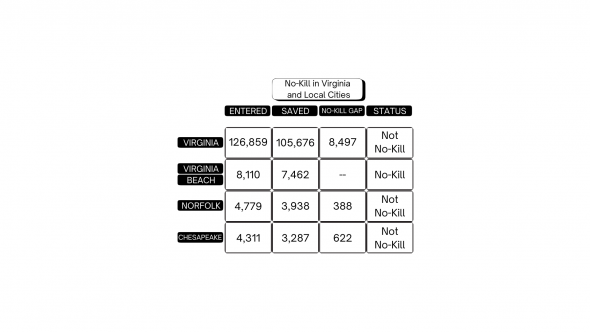Data collected from 2023 showing the status of Virginia and local cities’ animal shelters sourced from Best Friends Animal Society.
Isaac Fick|Marlin Chronicle
While declaring November as Virginia Loves Shelter Animals Month, Governor Glenn Youngkin encouraged all Virginians to achieve no-kill in 2025.
According to the certificate of recognition, no-kill is a “commitment to saving every healthy or treatable dog and cat in a shelter who can be saved and striving for at least 90% of the companion animals that enter its facilities to leave alive.”
If 0.1% more Virginians adopt rather than purchase animals, the no-kill standard for Virginia animal shelters would be met, “which would make Virginia the largest no kill state to date,” according to the recognition.
In the recognition, it is said that “Virginians should work together to achieve ‘No-Kill’ in the Commonwealth in 2025, and animal shelters can do this by employing lifesaving programs such as foster care networks; adoption programs; medical and behavioral programs; public education and awareness programs; and animal socialization programs to prioritize lifesaving.”
Best Friends Animal Society, a nonprofit organization that aims to save animals and provide them with homes, has a statement on the no-kill goal.
As stated in the Best Friends website, “No-kill is a benchmark Best Friends has established to help guide where we focus our efforts to save the lives of the pets most at risk in shelters.”
“In 2023, 415,000 dogs and cats were killed in our nation’s shelters just because they didn’t have safe places to call home,” according to the website.

Elliot Fylstra|Marlin Chronicle
Best Friends’ benchmark is in line with Youngkin’s, being a 90% save rate. The reason they arrived at this benchmark is because “Typically, no more than 10% of dogs and cats entering shelters are suffering from irreparable medical or behavioral issues that compromise their quality of life and prevent them from being rehomed.”
People for the Ethical Treatment of Animals (PETA) argue for a form of opposition, that focus should not be placed on no-kill, and instead spay and neuter resources, according to their website. As stated on their website, “Finding a home for one dog may save one life, but sterilizing one dog will save hundreds, if not thousands, of dogs’ lives by preventing generations of potentially homeless puppies from being born.”
“My personal view aligns with some of PETA’s views; no-kill literally doesn’t exist,” Kathy Bartkus said. “The label is a misnomer.”
Bartkus is active in the local shelter and rescue community and worked at Virginia Wesleyan before she retired and facilitated “Animals and Society” class activities and local connections for the class.
“Even those shelters who meet the standards for a ‘no kill’ label still euthanize un-adoptable pets,” she said. “Those shelters also indirectly affect the kill rates at their local open admission shelters by turning pets away when they’re full. Those pets are then surrendered to their local open admission shelter, where they face the possibility of euthanization.”
“I truly wish the founders of the movement chose a different name,” Bartkus said. She said that open-admission shelters are often labeled “kill shelters,” hurting their reputation. This labeling negatively affects the employees of shelters, too.
“Employees at those shelters are regarded as ‘animal killers’ by less informed members of the public,” Bartkus said.
According to the Animal Humane Society website, no-kill is “language we don’t ― and we won’t ― use, to describe ourselves or any other animal rescue agency.”
One of the reasons for this agrees with Bartkus, because “the ‘no-kill’ movement has actually been harmful to animals, as the organizations who need the most support have fallen out of favor with the public — all due to a divisive, and misunderstood label,” according to the website.
As said by the website, “The actual number of animals placed should be celebrated, not just the percentage.”
In a Nov. 28 story from Best Friends, Julie Castle explained that there is, based on the first three quarters of 2024, a 3.4% decrease nationally in healthy animals killed. If this continues, it represents the first positive national trend in lifesaving since 2020, Castle said.
The Best Friends website contains a national overview of the no-kill status. All of the data is based on 2023 and predictive modeling. For Virginia, the save rate is 83.3%, with 78 of its 138 shelters having the no-kill status.
The overview also identifies cities and the shelters within them. Norfolk has two shelters: the Norfolk SPCA, which is no-kill, and the Norfolk Animal Care Center, which is not.
Norfolk SPCA has reached no-kill, with 1,315 animals entered and 1,208 saved, having a 91.86% save rate. Norfolk Animal Care Center, with 3,464 animals entered and 2,730 saved, has a 78.81% save rate.
By Isaac Fick

